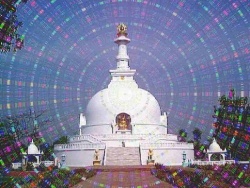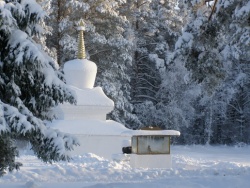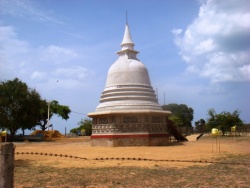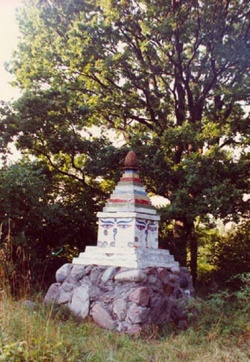The Life of the Buddha Shakyamuni as Commemorated by Eight Stupas
By Wei Lin and Chris Moore
26 May, 1998
The eight Mahachaityas, as depicted in this painting, commemorate eight sites associated with events in the life of the Buddha Shakyamuni. These events are known as the astamahapratiharya, or "eight great conjuror's illusions" (Huntington, Susan and John, 531-33). These sites constitute a pilgrimage cycle, the completion of which results in potential rebirth into a heaven realm. Although the original Mahachaityas are located in India and Nepal, surrogate stupas were constructed throughout Tibet, inner Asia, and China to facilitate this pilgrimage. Indeed, it is likely that a devotee either commissioned this painting in lieu of taking the actual pilgrimage or perhaps to commemorate such a pilgrimage.
The Mahachaityas correspond to defining events in the Buddha's life: his birth at Lumbini; enlightenment at Bodhgaya; first sermon at the Deer Park at Sarnath; descent from Trayastrimsha heaven at Sankashya; the great miracle at Shravasti; taming of the wild elephant, Nalagiri, at Rajagriha (modern Rajgir); gift of the monkey at Vaishali; and his death, the nirvana, at Kushinagara. These sites are visited as a complete pilgrimage cycle and, objects such as this painting, serve as commemorative offerings. Although similar in appearence, the Mahachaityas are differentiated from one another by the stupa terraces, usually called the "drum" in most stupas, here represented as the step-like structures located between the stupa's base and its dome.
The large central stupa is the "Stupa of Enlightenment" or "Stupa of Victory over Mara." Characterized by its four terraces , this stupa commemorates the defining moment in the Buddha's life, his enlightenment at Bodhgaya (Bentor, 36; Tucci, 127). When Siddhartha Gautama sought enlightenment in meditation beneath the Bodhi tree, he was attacked by Mara, the embodiment of evil and death. Mara sent his demon army, embodying samsaric illusions, to attack him. These forces were defeated, their weapons becoming flowers falling harmlessly to the ground. Mara then sent his three beautiful daughters, Lust, Anger and Ignorance, to distract Siddhartha from his purpose. They became ugly hags in his presence. Mara's final attack was to challenge the right of Siddhartha to enlightenment and demanded that he produce a witness to bear testament to his attainments. Silently taping the gound with his right hand, Siddhartha summoned the earth goddess herself to bear witness to his right to enlightenment. The Buddha Shakyamuni is depicted within this stupa. He displays the "earth touching" mudra, symbolizing the moment in which the Buddha called the earth goddess to bear witness to enlightenment. With his enlightenment, his victory over Mara was complete. Thus, this stupa commemorates the internal struggle through which the Buddha overcame death and attained freedom from the cycle of Samsara.
The remaining seven Mahachaityas, will be discussed in their proper chronological order rather than in the order in which they are depicted, are arranged around the central image.
Second from the top left, is the "Stupa of the Heaped Lotuses," which commemorates Siddhartha Gautama's birth at Lumbini. This stupa is characterized by lotus petals decorating the terraces (Bentor, 36; Tucci, 127). Siddhartha Gautama was born from the side of Maya Devi as she grasped the branch of a tree. Soon after his birth, Siddhartha took seven steps in each of the four cardinal directions stating, "I will reach the highest nirvana, I will be the first of all creatures, This will be my last birth, I will cross the ocean of existence" (Rockhill, 16). At the time of Siddhartha's birth, Mayadevi was attended by two Brahmanic gods, Indra and Brahma, Indra acting as midwife. Thus, this stupa also commemorates the establishishing of the Buddha-to-be's preeminence over the brahmanical religion from the time of his birth.
The next great event in the Buddha's life was his enlightenment, represented by the central stupa, discussed above.
The third event, the Buddha's first sermon given at the "Deer" park near Varanasi is commoreated by the stupa in the upper left hand corner of the painting. It is known as the "Stupa of Many Gates," and is characterized by having doorways on its terraces, symbolizing the many gates to enlightenment provided by the Buddha's Dharma (Bentor, 36; Tucci, 127). During his first teaching the Buddha preached to five ascetics, with whom he had previously performed physical austerities. They became his disciples and first monks. With the first sermon, the door of the Dharma was opened and the Buddhist teachings were available to all sentient beings. Thus, the stupa is also known as "the stupa of complete knowledge."
In the Tibetan tradition, the "The Stupa of Miracles" is fourth in the sequence. It commemorates the Buddha's victory over heretics at Shravasti in a contest of pratiharya , or "conjuror's illustions." This stupa is characterized by projections in the center of each of the four sides (Bentor, 36; Tucci, 128). This feature is not clearly represented in this painting, thus, the stupa is either the one in the lower left hand corner of the painting or the one in the bottom center. In this event the Buddha, in meditation, defeated the heretics by causing a rainbow to appear in the sky. He then multiplied himself, so that every spectator believed that he or she was being preached to by the Buddha himself. The multitude of Buddhas ultimately collapsed into a single Buddha from whose feet emerged rain and from whose shoulders issued fire. This event demonstrates the universality of Buddhahood and the potential of every individual's own enlightenment.
In the upper left hand corner, is the "Stupa of the Decent with the Gods' Realm." It commemorates the Buddha's descent at Sankashya from the Trayastrimsha heaven where he spent three months preaching the Dharma to his mother, Mayadevi. The traditional Tibetan sequence places the following event fifth although in Indian lists it is usually fourth. This stupa is characterized by the staircase on its base, symbolizing the triple staircase down which the Buddha descended (Bentor, 36). This event further demonstrates the Buddha's superiority over the Brahmanic gods, for he is flanked in his descent by Indra and Brahma, acting as attendant figures. Notably, it was at the base of this staircase that the Buddha gave the prediction of enlightenment to Utpali, a nun who was magically transformed into a royal prince so that she could be the first to greet the Buddha upon his return. This incident is founded in the Mahayana belief that all future Buddhas must receive a prediction of enlightenment from a fully enlightened Buddha.
Next to the "Stupa of Miracles," either the bottom left or center, is the "Stupa of Reconciliation." As stated above, these two stupas cannot be clearly differentiated. The "Stupa of Reconciliation" has an octagonal base (Gega lama, 83, 91). While this is a clear difference sculpturally and in most drawings, it is unclear as rendered in this painting. In Tibet, the "Stupa of Reconciliation" commemorates the Buddha's resolution of a disagreement among in the Sangha, or community of monks, through the use of magical transformations and through the agency of his two disciples Sariputra and Mahamaudgallyayana. In India, this stupa represents the Buddha's taming of a rogue elephant at Rajagriha, symbolizing the taming of the unbridled mind. In both instances the conflict was caused by Devadatta, the Buddha's evil cousin. Also, in both events the Buddha acted on behalf of all sentient beings to resolve the conflict (Bentor, 36).
At the center of the right side, is the stupa commemorating the "Buddha's Complete Victory" also known as the the stupa of the [ability to] "Control the Life Span." it is characterized by three rounded steps at the drum level this stupa commemorates the Buddha's decision to remain on earth another three months. In India, this decision is connected to the story of the "Gift of the Monkey," taking place at Vaisali. After having witnessed the death of a faithful monkey, the Buddha realized that he too must die but decided to remain among his followers for another three months. In Tibet, it is believed that the Buddha reached this realization after meditating or while giving a sermon. Regardless, the stupa further emphasizes the Buddha's control over his own life span. (Bentor, 36; Gega Lama, 81, 93).
The stupa in the lower right corner of the painting commemorates the Buddha's death, or great cessation Mahaparanirvana, at Kushinagara. The stupa's defining characteristic is that it lacks the drum between the dome of the stupa and the base (Bentor, 36; Gega Lama, 92). The usual Tibetan representation of this stupa lacks a "window" into the center and the dome usually has the shape of an inverted [elongated] begging bowl. This stupa commemorates the Buddha's final victory over samsara in which by his nirvana, he reintegrates into the void, or sunyata, never to be reborn again.
These stupa embody Shakyamuni's compassion which was manifested by his displays, or pratiharya. The assumption is that his entire life was essentially a performance of displays for the benefit of sentient beings, and that the Buddhist essence that was Shakyamuni was only a reification of the Dharmakaya through the nirmankaya, or transformataion body. In a more material sense, these stupas commemorate the locations of the great events of the life of the teacher and as such are considered a form of relic called a paribhogika. The stupas serve as the loci of the sites and the center of a cult of pilgrimage that was extensively practiced in Eastern India from the time of Shakyamuni until recent times when there has been a major renewal of interest in the sites. They are also the protypical sites for pilgrimages throughout the Buddhist world. Surrogate sets of eight sites exist in Sri Lanka, Burma, China and Tibet where one can essentially preform the pilgrimage without going to India.
These paintings are reflective of a belief in a process by which one could attain rebirth in a heaven world by offering the set. (Huntington & Huntington, 531-533) Although no particular heaven is mentioned in the text, it may be assumed that the Tibetan patron of this painting hoped for a rebirth in either Sukhavati or Tushita, two of the most popular heaven worlds availabe to the Buddhist devotee.
References:
Bentor, Yael. "In Praise of Stupas: The Tibet Eulogy at Chu-Yung-Kuan Reconsidered." Indo-Iranian Journal 38 (1995): 31-54.
Gega Lama. Principles of Tibetan Art, Darjeeling (rDo rje gLing): Jamyang Singe publisher, 1983. vol. 2, p. 81-83 has been used for the names of the stupas throughout.
Huntington, Susan L. and John C. Leaves from the Bodhi-tree: The Art of Pala India (8th -12th centuries) and Its International Legacy. Dayton (Ohio), Seattle and London: Dayton Art Institute and University of Washington Press, 1990.
Rockhill, W. Woodville. The Life of the Buddha and the Early History of His Order: Derived from Tibetan Works in the Bkah-hgyur and Bstan-hgyur. London: Kegan Paul, Trench and Trubner & Co. 1907.
Tucci, Giuseppe. Stupa: Art, Architectonics and Symbolism. trans. Uma Marina Vesci. New Delhi: Aditya Prakashan, 1988.




